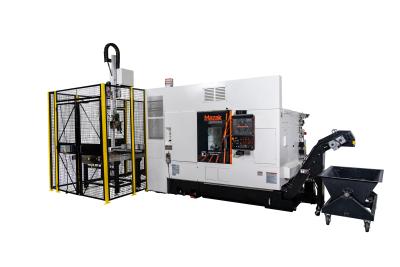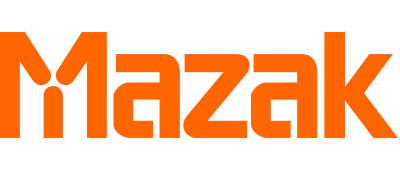
To help manufacturers achieve the highest level of overall throughput, Mazak Corp. has designed its Kentucky-built QUICK TURN 200/250 series of CNC turning centers as a flexible machine base suitable for numerous highly productive configurations. One such example, the QUICK TURN 250MSY multitask turning center with GR100 gantry robot, offers full Done In One part-processing capabilities and fully automated part loading/unloading with the robot for production efficiency.
Mazak pre-engineered the GR100 to easily integrate into any of the QUICK TURN 200/250 Series machine models, including the 2-axis, milling, Y-axis and/or second spindle versions. To interface with these QUICK TURN machines, the GR100 requires no special robot/machine interface and programs easily via the MAZATROL SmoothG CNC featured on the machines. For application flexibility, two GR100 workpiece-table configurations are available, as is end-of-arm tooling with three-jaw grippers.
All GR100 robots come equipped with a simple-to-configure, D3, two-sided, three-jaw gripping hand with a part range up to 7” in diameter, 6” in length and total weight of 44 lbs. The field-proven D3 hand design allows shops to load/unload a wide variety of chuck work. To significantly reduce machine idle time, Mazak complements the GR100 with the integration of a fast, servo-driven automatic door that allows the robot entry into the machine envelope at a 3,937-ipm rapid rate on the robot’s A-axis and 7,087-ipm rapid rate on its B-axis.
The QUICK TURN 250MSY headstock features a 10" main chuck mounted on a 35-hp, 4,000-rpm integrated spindle motor that generates 343 ft-lbs of torque for heavy-duty metal removal. To accurately position parts for square facing/slotting cuts and precisely drilled holes, the machine’s main turning spindle also serves as a full-functioning C-axis that is programmable in 0.0001-degree increments. A second spindle with 15 hp, 6,000 rpm and a 6" chuck allows the QUICK TURN 250MSY to automatically transfer parts and perform secondary operations with speed and accuracy.
The machine’s 12-position, direct-drive turret eliminates the use of belts for improved part surface finishes and reduced maintenance. It can be configured with either VDI or bolt-on tooling. The turret’s rotary tool spindle delivers 10 hp, 6,000 rpm and 52 ft-lbs of torque. And with an optional tooling package, 10,000 rpm is available.
The GR100 robot package offers two-workpiece table configurations, including a two-pallet changer that allows parts to be positioned in rows across each table and a 16-position rotary stocker system with the ability to stack parts on each individual stocker. The two-pallet changer makes it possible for operators to access the pallet on one table while the other table is shuttled into the load/unload area for uninterrupted machine operation. The rotary table design with stacked parts allows for greater initial density of parts but without access during automatic operation. A single part-discharge tray can also be added for unloading specified parts for inspection.
Contact Details
Related Glossary Terms
- centers
centers
Cone-shaped pins that support a workpiece by one or two ends during machining. The centers fit into holes drilled in the workpiece ends. Centers that turn with the workpiece are called “live” centers; those that do not are called “dead” centers.
- chuck
chuck
Workholding device that affixes to a mill, lathe or drill-press spindle. It holds a tool or workpiece by one end, allowing it to be rotated. May also be fitted to the machine table to hold a workpiece. Two or more adjustable jaws actually hold the tool or part. May be actuated manually, pneumatically, hydraulically or electrically. See collet.
- computer numerical control ( CNC)
computer numerical control ( CNC)
Microprocessor-based controller dedicated to a machine tool that permits the creation or modification of parts. Programmed numerical control activates the machine’s servos and spindle drives and controls the various machining operations. See DNC, direct numerical control; NC, numerical control.
- gang cutting ( milling)
gang cutting ( milling)
Machining with several cutters mounted on a single arbor, generally for simultaneous cutting.
- gantry robot
gantry robot
Robot positioned by means of an overhead supporting structure such as a crane or bridge-type support.
- milling
milling
Machining operation in which metal or other material is removed by applying power to a rotating cutter. In vertical milling, the cutting tool is mounted vertically on the spindle. In horizontal milling, the cutting tool is mounted horizontally, either directly on the spindle or on an arbor. Horizontal milling is further broken down into conventional milling, where the cutter rotates opposite the direction of feed, or “up” into the workpiece; and climb milling, where the cutter rotates in the direction of feed, or “down” into the workpiece. Milling operations include plane or surface milling, endmilling, facemilling, angle milling, form milling and profiling.
- turning
turning
Workpiece is held in a chuck, mounted on a face plate or secured between centers and rotated while a cutting tool, normally a single-point tool, is fed into it along its periphery or across its end or face. Takes the form of straight turning (cutting along the periphery of the workpiece); taper turning (creating a taper); step turning (turning different-size diameters on the same work); chamfering (beveling an edge or shoulder); facing (cutting on an end); turning threads (usually external but can be internal); roughing (high-volume metal removal); and finishing (final light cuts). Performed on lathes, turning centers, chucking machines, automatic screw machines and similar machines.

